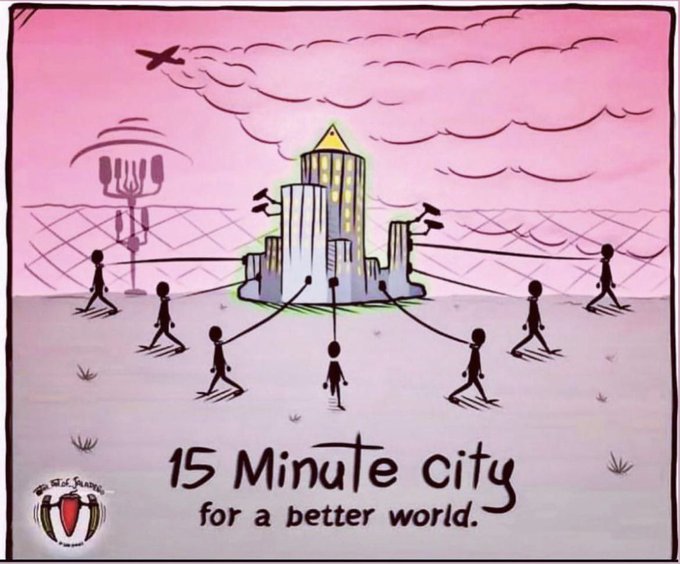15 minutes cities
Sources:
- The network of cities behind the initiative'.
- The full report presenting the vision.
- The C40, partner of the WEF.
- Examples of the work of a pilot city.
- Press article.
- Press article.
- You don't need a car anyway...
15-minute walk
To move towards the highly debatable goal of Net Zero, the idea would be to have cities divided into neighborhoods where all services would be accessible within a 15-minute walk.
Presented positively, the calculation is actually driven by the self-imposed constraint of cities to reduce their CO2 emissions by 25 to 30% by 2030. The only way (according to them) to achieve this: reduce car mileage, and the only way (according to them) to achieve this: impose the division into neighborhoods.
The project comes from C40, a group of large cities mobilized around the "climate crisis" and, of course, associated with the WEF.
The idea may seem attractive, but its implementation raises questions...
- To what extent will citizens be confined to their neighborhood? Will they have the right to leave their neighborhood? How? When? How many times a year?
- What physical measures will be put in place to lock down the neighborhoods? Barriers? Controls? Automated video surveillance?
- What penalties and fines will be imposed for non-compliance or exceeding travel quotas?
- As the goal is to eliminate cars, what other measures will be implemented? Urban tolls? Taxes on parking lots? Taxes on polluting vehicles?

Behind the attractive facade lie serious risks to our freedom:
- Obviously, our freedom of movement will be reduced to nothing. We will have to systematically justify all our movements outside the authorized zone.
- Could control measures be used for purposes other than the "simple" control of access to different zones?
- In case of unrest, why wouldn't cities use these zones to prevent large-scale protests?
And as always, these measures will primarily penalize the poorest, those who need to travel for work or to take care of a relative, and who cannot afford the various taxes or purchase a new, less polluting vehicle.
Lastly, it is worth noting that the majority of the effort is focused on issues that can justify new surveillance and control measures... Are we really talking about an environmental policy?
But it goes even further...
Beyond the control of individual movements, the C40 plan extends to other areas:
- Clothing: fewer new garments per person per year (37% in 2030 and 64% in 2050!) "Ambitious goal: 3 pieces of clothing per person per year in 2030" (3 garments per person per year).
- Food: less meat and animal products... but more crickets! "Ambitious goal 2030: 0kg of meat consumption and 0kg of dairy consumption" (0kg of meat and dairy products per year).
- Reduction of air travel.
- Automobile: discussed earlier, but it is indeed about eradicating private property: "ambitious goal: 0 private vehicle" (0 private vehicle) You'll own nothing and you'll be happy.
- Thermal efficiency of buildings. The measure is relevant, but here too, everything is in the implementation: mandatory renovations and a complex regulatory framework will make home ownership increasingly difficult for individuals. It's the Net Zero of primary residence ownership, disguised as an environmental policy...
As always, the goal is not to question the principle of reducing emissions, but to warn about an authoritarian implementation, depriving individuals of their possessions and freedoms. Is it about saving the planet or enslaving us?